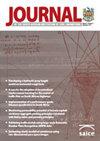An experimental study of the mechanical behaviour of squat shear walls built with precast concrete two-way hollow slabs
IF 0.6
4区 工程技术
Q4 ENGINEERING, CIVIL
Journal of the South African Institution of Civil Engineering
Pub Date : 2022-07-05
DOI:10.17159/2309-8775/2022/v64no2a5
引用次数: 0
Abstract
This paper proposes an innovative precast shear wall system built with precast concrete two-way hollow slabs (PCHS shear walls). In the joints of the precast panels of the PCHS shear walls, noncontact lap splices of rebars with vertical and horizontal holes are used to connect adjacent precast panels. These panels contribute to an automated assembly and facilitate pouring concrete in-situ. The mechanical behaviour of PCHS shear walls and the connection performance of vertical joints are examined through pseudo-static loading testing on one cast-in-situ concrete shear wall and four PCHS shear walls. Moreover, the influences of different parameters, including axial compression ratio, aspect ratio and the magnitude of horizontal distribution reinforcements, were analysed. It was found that the "strong bending and weak shear" requirement was achieved for all specimens. For the PCHS shear walls, the typical prominent diagonal cracks and brittle failure were prevented by the shear slippage at vertical joints and vertical cracks. And the vertical joint enabled the PCHS shear walls to exhibit stable load-bearing capacity with extensive deformations. In addition, the displacement ductility coefficient of all PCHS shear walls was over 5.0, and their ultimate drifts were over 1/100. The bearing capacity was improved with the increase of the axial compression ratio or with the decrease of the aspect ratio, but the deformation capacity was weakened.预制混凝土双向空心板深蹲剪力墙受力性能的试验研究
本文提出了一种创新的用预制混凝土双向空心板(PCHS剪力墙)建造的预制剪力墙系统。在PCHS剪力墙预制板的接缝中,使用具有垂直和水平孔的钢筋的非接触搭接来连接相邻的预制板。这些面板有助于自动化组装,并有助于现场浇筑混凝土。通过对一块现浇混凝土剪力墙和四块PCHS剪力墙的拟静力荷载试验,研究了PCHS剪力墙上的受力性能和竖向节点的连接性能。此外,还分析了轴压比、纵横比和水平分布钢筋数量等不同参数的影响。研究发现,所有试样都达到了“强弯曲和弱剪切”的要求。对于PCHS剪力墙,垂直接缝和垂直裂缝处的剪切滑移防止了典型的突出对角裂缝和脆性破坏。垂直接缝使PCHS剪力墙在大变形的情况下表现出稳定的承载能力。此外,所有PCHS剪力墙的位移延性系数均超过5.0,其极限位移均超过1/100。随着轴压比的增大或纵横比的减小,承载力有所提高,但变形能力有所减弱。
本文章由计算机程序翻译,如有差异,请以英文原文为准。
求助全文
约1分钟内获得全文
求助全文
来源期刊
CiteScore
0.70
自引率
25.00%
发文量
19
审稿时长
>12 weeks
期刊介绍:
The Journal of the South African Institution of Civil Engineering publishes peer reviewed papers on all aspects of Civil Engineering relevant to Africa. It is an open access, ISI accredited journal, providing authoritative information not only on current developments, but also – through its back issues – giving access to data on established practices and the construction of existing infrastructure. It is published quarterly and is controlled by a Journal Editorial Panel.
The forerunner of the South African Institution of Civil Engineering was established in 1903 as a learned society aiming to develop technology and to share knowledge for the development of the day. The minutes of the proceedings of the then Cape Society of Civil Engineers mainly contained technical papers presented at the Society''s meetings. Since then, and throughout its long history, during which time it has undergone several name changes, the organisation has continued to publish technical papers in its monthly publication (magazine), until 1993 when it created a separate journal for the publication of technical papers.

 求助内容:
求助内容: 应助结果提醒方式:
应助结果提醒方式:


